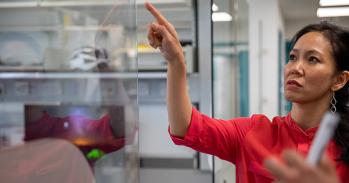
Scientists are close to discovering how normal breast cells become cancerous, according to research published today.
Scientists are close to discovering how normal breast cells become cancerous, according to research published today.
In the UK 12,000 women die from this disease every year, so it is vital we understand how breast cancer develops in order to stop it happening.
Arlene Wilkie
Dr Paul Edwards at the Department of Pathology has identified a gene, NRG1 (neuregulin-1), which is damaged in over half of all breast cancers and fails to guard against normal cells becoming breast cancer cells.
Finding the genes involved in breast cancer development is essential to classify different types of the disease so that the most effective treatment is given for the specific type of breast cancer.
Dr Edwards said, "I believe NRG1 could be the most important tumour suppressor gene discovery in the last 20 years as it gives us vital information about a new mechanism that causes breast cancer. It could also be relevant to a wide range of other common cancers and could lead to new and effective treatments."
Arlene Wilkie, Director of Research and Policy, Breast Cancer Campaign, which funded the study with Cancer Research UK said: "Knowing the identity of this gene will lead to far more detailed studies of how it works and how it is involved in breast cancer development. This research is a major step forward in understanding the genetics of cancer and could open up a host of new strategies to improve diagnosis and treatment.
"In the UK 12,000 women die from this disease every year, so it is vital we understand how breast cancer develops in order to stop it happening."
Lesley Walker, Cancer Research UK's director of cancer information, said: "This discovery is an important step forward in understanding a disease that more than 45,500 women are diagnosed with in the UK each year. More research is now needed to understand how this 'guard' gene is silenced and how exactly this influences the development of cancer. It might then be possible to develop ways to bypass the gene or target treatments to the defect."
This work is licensed under a Creative Commons Licence. If you use this content on your site please link back to this page.





